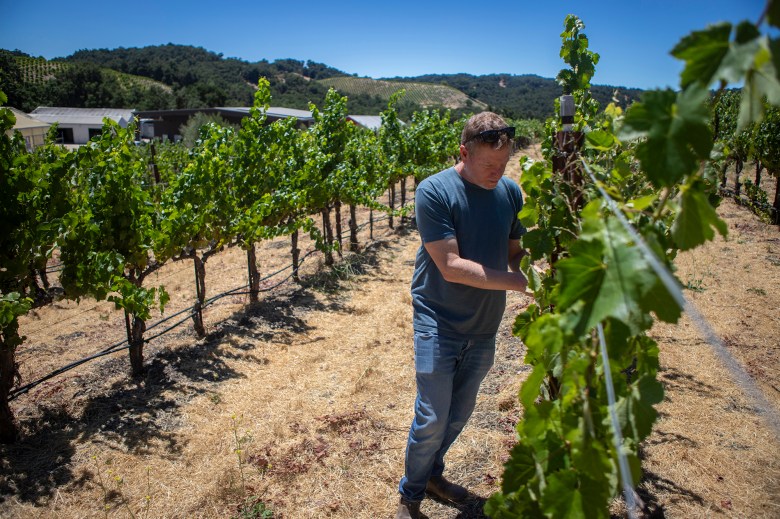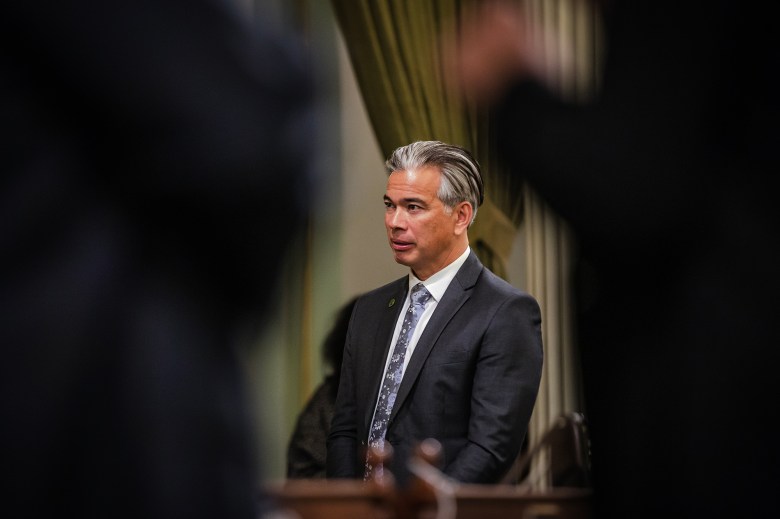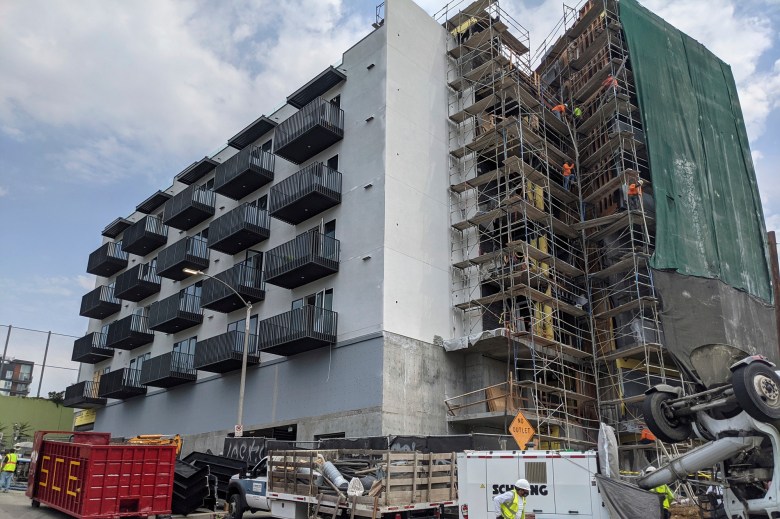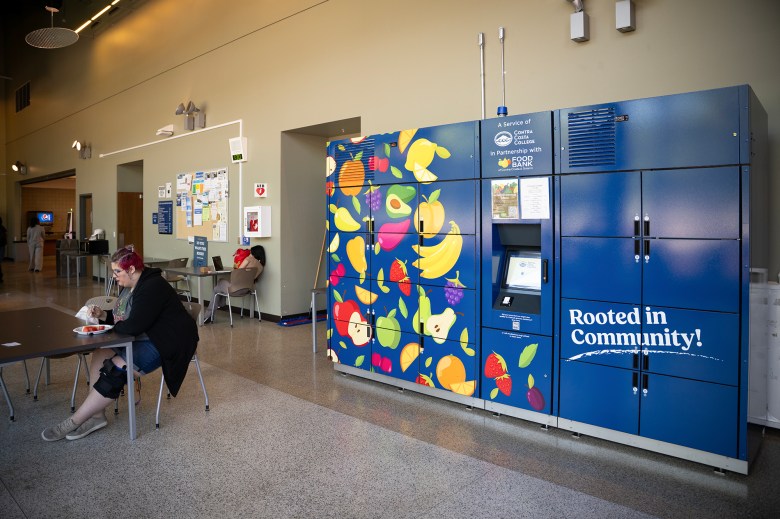 Jason Haas, owner of Tablas Creek Vineyard, at his vineyard in Paso Robles on July 30, 2025. Photo by Larry Valenzuela, CalMatters/CatchLight Local
Jason Haas, owner of Tablas Creek Vineyard, at his vineyard in Paso Robles on July 30, 2025. Photo by Larry Valenzuela, CalMatters/CatchLight Local
Amid decreasing demand and rising costs, the U.S. and California wine industry have struggled in recent years. But while some in the industry regard President Donald Trump’s tariff policies as bad for business, others say they could help domestic wine makers, writes CalMatters’ Levi Sumagaysay.
Since the beginning of August, the Trump administration has enacted a 15% tariff on most European goods, including wine. Though negotiations remain ongoing, some American winemakers, restaurant owners and others are urging Trump to exclude European wines from tariffs because of the ripple effects it could have on the wine business ecosystem.
In California especially — which leads the U.S. in wine-related tourism and exports — wine importers, distributors, retailers and restaurants rely on selling European wines for revenue. Their ability to distribute American wine is also influenced by how much other wine they can move.
Paul Einbund, owner of two Bay Area restaurants: “A lot of my diners just won’t drink domestic (wine). … People up and down the supply chain are in trouble.”
In 2022, California’s wine industry generated about $88 billion and the state’s wine exports totaled $1.3 billion.
But others aren’t entirely convinced that exempting European wines from tariffs would help the ailing industry in the U.S. They argue that since European winemakers are subsidized, California wine producers are already at a disadvantage. The European Union spends more than 1 billion euros a year to help boost European wine, and some countries have their own subsidy programs.
Richard Samra, a grape grower in the Sacramento Delta and Lodi for 40 years: “U.S. wine grape growers don’t have that. We want to level the playing field. We have plenty of grapes and wine available for sale.”
Read more here.
CalMatters events: On Sept. 17 CalMatters’ Alejandro Lazo will hold a panel to discuss how California can overcome its clean energy challenges as Trump and congressional Republicans work to dismantle key climate policies. Register here to attend in person at Manny’s in San Francisco or virtually.
Other Stories You Should Know
State AG’s status report on Trump lawsuits
 California Attorney General Rob Bonta at the state Capitol in Sacramento on Jan. 4, 2023. Photo by Rahul Lal for CalMatters
California Attorney General Rob Bonta at the state Capitol in Sacramento on Jan. 4, 2023. Photo by Rahul Lal for CalMatters
Bay Area case challenges CA approach to affordable housing
 Construction workers finish the exterior of an apartment building in Los Angeles on June 18, 2021. Photo by Damian Dovarganes, AP Photo
Construction workers finish the exterior of an apartment building in Los Angeles on June 18, 2021. Photo by Damian Dovarganes, AP Photo
One of the most common methods California uses to create affordable housing could be thrown into question by a recent lawsuit challenging the city of East Palo Alto’s authority to charge a housing fee.
As CalMatters’ Ben Christopher explains, about 149 California cities and counties have “inclusionary zoning” rules that require developers of new housing projects to pay for the state’s shortage of affordable homes. Developers typically do this by setting aside a portion of new units for lower-income tenants, but they can also pay a fee if they refuse.
Last week, East Palo Alto resident Wesley Yu filed a lawsuit in federal court after the city’s inclusionary zoning rules required him to sell or rent out one of the two housing units he was planning to build at an “affordable” rate. If not, he’d have to pay a $54,891 one-time fee.
Describing the fee as “extortion,” Yu and his legal team are relying on a U.S. Supreme Court decision to refute the zoning rules. The high court ruled last year that local governments must show that certain fees they charge builders must be “roughly proportionate” to the fiscal impact of the development.
Read more here.
And lastly: Feeding CA college students
 A student eats at the Contra Costa College dining hall in front of refrigerated food lockers in San Pablo on May 8, 2025. Photo by Florence Middleton for CalMatters
A student eats at the Contra Costa College dining hall in front of refrigerated food lockers in San Pablo on May 8, 2025. Photo by Florence Middleton for CalMatters
California Voices
CalMatters columnist Dan Walters: After former Vice President Kamala Harris declared she would not seek the governorship, the field of candidates remains crowded, and there is no clear frontrunner.
Other things worth your time:
TX redistricting move would ‘trigger’ new CA maps, Newsom says // Los Angeles Times
How Big Oil got Newsom to change his tune // Politico
CA conservatives rally to recall Newsom again despite prior failures // The Sacramento Bee
AT&T, ordered to keep providing land-line service, takes fight to CA legislature // The Mercury News
CA bill would require police to disclose use of AI in writing reports // KQED
Some Californians carry passports in fear of ICE. ‘We’re being racially profiled’ // The Fresno Bee
New evacuation warnings issued in SLO County as Gifford Fire grows to 65,000 acres // The Tribune
Calls grow for boosting Mono Lake by easing LA’s water reliance // Los Angeles Times
.wp-block-group__inner-container > :not(h2){margin: 16px 40px !important;}.cm-cta.long-ask .wp-block-group .wp-block-group__inner-container{display: flex;gap: 12px;align-items: center;}.cm-cta.long-ask figure{max-width: 40px;flex-shrink: 0;}.cm-cta.long-ask .wp-block-group p{font-size: 18px;font-weight: 700;line-height: 120%;letter-spacing: -0.36px;width: 100%;}.cm-cta.long-ask .wp-block-group .wp-block-buttons{flex-shrink: 0;}.cm-cta.long-ask .wp-block-button__link{padding-left: 40px;padding-right: 40px;}@container long-ask (min-width: 601px){.cm-cta.long-ask *{font-size: 16px;}}@container long-ask (max-width: 600px){.cm-cta.long-ask h2,.cm-cta.long-ask .wp-block-group p{text-align: center;}.cm-cta.long-ask h2{background: linear-gradient(90deg,#FFE094 0%,#FFB500 100%);padding: 12px 20px;font-size: 20px;letter-spacing: -0.4px;}.cm-cta.long-ask .wp-block-group .wp-block-group__inner-container{flex-direction: column;}.cm-cta.long-ask > .wp-block-group__inner-container > :not(h2){margin: 16px 20px !important;}}]]>
Nonpartisan, independent California news for all
We’re CalMatters, your nonprofit and nonpartisan news guide.
Our journalists are here to empower you and our mission continues to be essential.
We are independent and nonpartisan. Our trustworthy journalism is free from partisan politics, free from corporate influence and actually free for all Californians.
We are focused on California issues. From the environment to homelessness, economy and more, we publish the unfettered truth to keep you informed.
We hold people in power accountable. We probe and reveal the actions and inactions of powerful people and institutions, and the consequences that follow.
But we can’t keep doing this without support from readers like you.

Please give what you can today. Every gift helps.
![]()
Lynn La is the newsletter writer for CalMatters, focusing on California’s top political, policy and Capitol stories every weekday. She produces and curates WhatMatters, CalMatters’ flagship daily newsletter…
More by Lynn La


Dining and Cooking